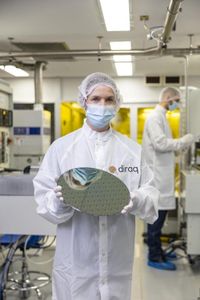On March 25, 2025, researchers at Diraq and the Fermi National Accelerator Laboratory (Fermilab) announced they have been awarded the US Department of Energy's (DOE) Quandarum project under the Quantum Information Science Enabled Discovery (QuantISED) program. This groundbreaking collaboration aims to develop quantum sensors intended for probing dark matter and advancing fundamental physics research.
The Quandarum project's main objective is to explore high-energy physics through an innovative quantum sensor built on the integration of two specialized technologies: Diraq’s silicon spin qubits and Fermilab’s cryogenic "skipper" analog-to-digital converter (ADC) circuits. This ultrasensitive quantum sensor is designed specifically to detect electromagnetic signatures that may link to axions, hypothetical particles some physicists believe constitute dark matter.
Dark matter continues to be a profound mystery in modern physics, constituting about 27% of the universe yet remaining undetected by conventional methods. By employing quantum technologies, researchers hope to push beyond the Standard Model of particle physics and enhance the understanding of the fundamental nature of the universe.
Diraq is renowned for its expertise in developing silicon-based quantum computing technology, making it a vital partner in this project. Diraq CEO and Founder Andrew Dzurak elaborated on the significance of this collaboration, stating, "Diraq is a natural project partner for Fermilab in the Quandarum project due to our expertise in silicon spin-based qubits. This collaboration represents an opportunity to leverage our patented spin qubit chip technology in an exciting new field, advancing our spin readout capabilities while enabling the improved detection of subatomic particles."
Fermilab, which leads the Quandarum project, is a prominent particle physics laboratory in the US, noted for its commitment to exploring the fundamental components of matter and the forces that govern them. With the support of the DOE, the project is one of 25 selected for funding, collectively amounting to $71 million aimed at fostering innovative research in quantum technologies for scientific discovery.
The collaborative effort will include contributions from esteemed institutions such as the University of Wisconsin–Madison, University of Chicago, and Manchester University. Each organization will play a pivotal role, specifically in developing two initial prototypes of the quantum sensor, supported with Diraq’s technical and theoretical expertise.
The project anticipates utilizing the properties of spin qubits, which hold information based on the orientation of electron spins, to deliver extraordinarily precise measurements of electromagnetic fields. "We can't directly measure what the direction of the spin is, but we can measure small movements of charge because moving charge creates a change in the electric field which can be measured," explained Adam Quinn, a principal investigator and engineer at Fermilab.
However, reading the information from spin qubits poses unique challenges, primarily due to their sensitivity to environmental disturbances. Quinn noted, "The core challenge of this sensor is the readout, and the key to success is having the ability to read out information with minimal noise." To tackle this, the team will utilize advanced reading techniques based on cryogenic application-specific integrated circuits (ASICs), meticulously designed to ensure superior performance, especially in extreme environments like cryogenic chambers.
Fermilab engineers have developed improved skipper charge-coupled devices (CCDs) that enhance readout accuracy through a technique that allows for higher precision at the level of single electrons. By applying this technology to qubit readouts, the team hopes to produce a low-power, highly sensitive detector crucial for understanding dark matter. The ultimate aim over the next five years is to merge the spin qubit and skipper technology onto one chip, progressing through multiple prototypes to achieve the desired results.
Andrew Dzurak expressed optimism about the project’s innovations, stating, "In addition to quantum computing, the inherent characteristics and material properties of silicon spin-based qubits offer significant promise for large quantum-sensing array technology and particle detection applications." This ambitious endeavor could pave the way for large-scale quantum computing and sensing platforms.
The initial stages of the project will involve utilizing existing chips to create a proof of concept, although these early versions may not deliver peak performance. As time progresses, improvements should be developed through refined ASIC designs aimed at boosting operational performance.
Fermilab’s Microelectronics Division Head, Farah Fahim, noted the importance of collaboration in this research, stating, "This project exemplifies the power of interdisciplinary collaboration and innovation to advance quantum technologies for fundamental science. By combining Fermilab’s expertise in extreme environment electronics and constructing sensitive large-area detectors with Diraq’s world-class capabilities in silicon spin qubits, we will push the boundaries of quantum sensing to tackle the profound mysteries of our universe."
The Quandarum project is set to unfold over five years, driven by a vision to advance the landscape of quantum sensors and deepen the understanding of dark matter and high-energy physics. As the research progresses, it promises to illuminate significant aspects of our universe that remain shrouded in mystery.
In summary, this collaborative project uniting Diraq, Fermilab, and leading universities signifies a progressive step in the realm of quantum physics research. The hope is that through innovative technologies, a clearer picture of the cosmos will begin to emerge, leading to breakthroughs in the understanding of matter's fundamental nature and the forces that govern it.




